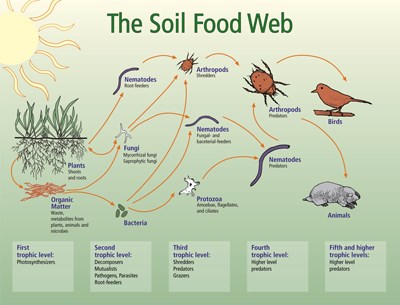Last week we delved into what is happening in the soil when winter arrives. We learned how the water within the soils freezes and that it is important to keep the frost levels from going deeper into the soil by ensuring our gardens are watered prior to freeze up. Thankfully, Mother Nature often takes care of this chore for us with late fall rains or early snows that melt into the soil.
We introduced the soil food web which is still living below the frost layer there in winter. There are many techniques used by plants, animals and even the tiniest critters that allow them to survive the winter. Some animals will burrow beneath the frost layer in the soil and either hibernate or exist on stored food but some of the soil animals have evolved to withstand temperatures below freezing. At least five species of frogs in North America make their own natural antifreeze that allows them to become completely frozen for long periods of time without suffering serious damage to cells. Many of the soil microbes (bacteria and fungi) are active in winter months. Studies done in Antarctica, show microbial life in permanently frozen ground or permafrost.
Many perennial plants grown in cold climates are also able to withstand extremely cold temperatures due to evolving factors. Some will develop root systems below the frost layer while others will also develop an antifreeze-like situation. The roots will release a lot of water into the surrounding soil and within the cells themselves a higher concentration of sugars and salts will lower the freezing point of the water that is still within and between the cells.
Other tiny organisms within the soil are able to survive by living in a microscopic film of water that adheres to soil particles. The bond energy between the water molecules and soil particles is so great that the thin layer of water does not freeze even at extremely low temperatures. The microbes living within this unfrozen water are able to survive and continue to work consuming organic matter and exhaling carbon dioxide. It is important at this point to think about the fact that a handful of soil contains more microbes than there are humans on earth! Being confronted with facts that are incomprehensible we are getting into the real science of soil.
Microbes, like bacteria and fungi, need food and energy to live. They depend on soil for their homes and their work is to decompose organic matter as well as weather rocks and minerals which provides nutrients within the soil in a form that plants can use. Many species of fungi will overwinter in the form of spores which as the soil warms, they begin to sprout, sending out masses of thread-like hyphae. Fungi recycle chemical elements that would otherwise remain locked up in dead plants and animals. Some decompose plant debris as they utilize the carbon and energy that come from the breakdown of dead and decaying plants. Bacteria perform a wide range of chemical transformations which are critical to growing and maintaining a healthy food supply. These millions of different microbes that live in the soil create a biodiversity that is in the most part beneficial to human health. It is our job to ensure that we do our part to keep our soils healthy!
A soil that is rich in organic matter helps these microorganisms to overwinter without harm. Recently, it was discovered that archaea microorganisms are likely the most ancient living things on earth. They have been found in every known environment including Yellowstone’s hot springs to ice floes in the Arctic. As they can live and reproduce in extraordinarily harsh ecologies, they are called extremophiles or lovers of the extreme!
Watch next week for the final article devoted to soils in winter and learn about how to keep your soil healthy and the role larger organisms play in the soil food web.
Hanbidge is the lead horticulturist with Orchid Horticulture. Find us at ; by email at [email protected]; on facebook @orchidhort and on instagram at #orchidhort.
Tune into GROW Live, weekly on our Facebook page or check out the Youtube channel GROW





